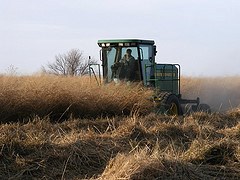The profitable production of switchgrass for biofuel today depends primarily on the price of oil, as well as the Renewable Fuel Standard (RFS).
Table of Contents
- Production Costs Hinge on Yields
- Market Value of Switchgrass
- The Role of Competing Fuel Products
- Use of Marginal Land for Switchgrass
- Potential Markets for Switchgrass
- Nonmarket Value of Switchgrass
- Summary
- For Additional Information
- Contributors to This Article
Introduction
In the Renewable Fuel Standard (RFS2) legislation passed in 2007, Congress escalated mandates for the amounts of biofuels to be used in transportation fuel sold in the U.S. Since then, corn ethanol has increased to almost the maximum limit specified by the RFS2, but the cellulosic ethanol mandate is far behind schedule. This is despite the fact that advanced biofuels such as cellulosic ethanol (derived from crop residues, grasses, and trees) are mandated to exceed the amount of corn ethanol produced. This tardiness is due to the fact that massive research and development efforts have so far failed to create tested, industrial-scale technology for the difficult process of turning cellulosic materials into biofuels.
Switchgrass is one of the grass crops promoted as a cellulosic biofuel feedstock. In this article, we summarize the economics of producing switchgrass for biomass. Note that it is not yet clear exactly how much of the mandated cellulosic biofuel use the government will eventually require.
Production Costs Hinge on Yields

The cost of producing switchgrass with current technology varies, but a reasonable average is about $65 per ton in the Upper Midwest. This is based on research in that region during the past five to ten years. This estimate is based on:
- Establishment costs of about $200 per acre, or $30 per acre when annualized over 10 years. These costs include seeding, chemicals, land rent, and reseeding as needed.
- Annual production costs estimated at $200 per acre. At a yield of 3.5 tons of dry matter (DM) per acre (a reasonable expectation in much of the Upper Midwest), this brings total cost at the farm gate to about $65 per ton of DM. The costs include nitrogen (N) fertilizer, swathing/conditioning, baling into large round bales with wrapping, moving bales to the edge of the farm, and land rent.
The final production cost per ton depends on average yields. For example, given the expenditures above, an average yield of 2 tons per acre would result in a cost above $110 per ton; at 6 tons per acre, the production cost would fall to about $38 per ton. New varieties are being developed that may provide higher yields than our estimate of 3.5 tons of DM.
Market Value of Switchgrass
We do not yet know what refineries will pay for switchgrass as cellulosic feedstock. At a minimum, they will have to pay at least its value as livestock feed, which is expected to be about $95 per ton of DM (equivalent to $83 per ton of 15%-moisture hay). If the RFS2 mandate is fully enforced, refiners might pay $150 per ton or more if corn stover (a cheaper cellulosic feedstock) is not available. Switchgrass as a cellulosic fuel feedstock will also face competition from other cellulosic sources, such as wood processing waste. These alternative feedstocks will limit the amount that processors are willing to pay for switchgrass.
Cash spot markets for biomass will be limited. All switchgrass grown for biomass is likely to be grown under contract with biorefineries because these plants will require a steady supply of large amounts of feedstock.
The Role of Competing Fuel Products
The economics of switchgrass for bioenergy are influenced not only by feedstock prices and production costs, but also by competing uses and products. Cellulosic fuels in general will not be competitive with corn ethanol due to higher production and refining costs. And without mandates, cellulosic ethanol is unlikely to be competitive with gasoline unless petroleum prices are consistently above $110 per barrel.
There are several pathways for converting cellulosic feedstocks such as switchgrass into bioenergy products, including hydrolysis and fermentation, pyrolysis, and gasification. Given budgeted costs for a pyrolytic biorefinery that produces half gasoline/half diesel, the price of oil must reach the vicinity of $110 per barrel in order to allow a switchgrass-based refinery to pay farm gate prices at or above current production costs. Therefore, the success of cellulosic ethanol is likely to depend on mandates or subsidies.
Will switchgrass converted into cellulosic ethanol be price-competitive with corn ethanol? It’s hard to imagine so in the current climate because even though the production costs of the two feedstocks are similar—about $1 per gallon of ethanol produced—the cost of operating cellulosic plants will be twice that of corn ethanol plants, and the construction costs for cellulosic plants to process switchgrass will be five or six times the cost of constructing corn ethanol plants in the past.
Use of Marginal Land for Switchgrass
It is widely assumed that switchgrass for biofuel would most likely be produced on land that is marginal for row-crop production. But do the economics justify that?
Generally, on marginal cropland that can produce corn at yields higher than 60 to 70 bushels per acre, corn is likely to be more profitable. However, on land that cannot consistently produce at least 60 bushels per acre or so, according to our calculations, switchgrass could be more profitable.
Potential Markets for Switchgrass
Switchgrass is a source of low-quality fodder for animals, and with hay prices expected to be in the $80-per-ton range (at 15% moisture), switchgrass might be more valuable as livestock feed than as a cellulosic feedstock.
There are other potential markets for switchgrass as an energy crop:
- Pellets for fuel. This market is too new to reliably determine the value of switchgrass for use as fuel pellets.
- Co-firing in steam boilers, usually with coal. However, switchgrass bales will not be price-competitive with coal, except perhaps in areas that have renewable-fuel portfolio mandate requirements. In these situations, marginal substitution of switchgrass for coal might be cheaper than substitution of other renewable fuels.
Nonmarket Value of Switchgrass

Growing switchgrass for biofuel can provide ecosystem services benefits that do not have a direct cash value—at least in today’s marketplace. These benefits include reduced soil erosion and fertilizer runoff, increased soil organic carbon that retains moisture and maintains fertility, and wildlife habitat. Still, some studies have attempted to put a dollar figure on these values. Some examples are:
- Debnath, et al, estimated that these intangible benefits could raise the value of a switchgrass crop by $13 to $46 per ton relative to intangible benefits from no-till wheat.
- Liebig, et al, measured increases in soil carbon sequestration under switchgrass and found an average increase of 1.1 Mg C/ha, which at the value the U.S. Environmental Protection Agency places on carbon emission reductions, would be worth $54 per acre (around $15 per ton).
Although producers don’t directly benefit monetarily from these non-cash values today, that might change in the future.
Summary
Many factors affect the economics of switchgrass grown for bioenergy, such as the cost of production, the price of other cellulosic feedstocks, alternative uses for the crop, the price of alternative fuels, and government fuel mandates. At current prices and technology, switchgrass for cellulosic ethanol is not a strong free market contender in most cases. However the RFS2 and the price of petroleum have the greatest potential impact on the economic prospects for growing switchgrass, and these two factors can certainly change the economic balance in favor of switchgrass for bioenergy.
For Additional Information
- Brown, Tristan R., Rajeeva Thilakaratne, Robert C. Brown and Guiping Hu. 2013. Techno-economic analysis of biomass to transportation fuels and electricity via fast pyrolysis and hydroprocessing. Fuel 106:463-469.
- Brown, Tristan R. and Robert C. Brown. 2013. A review of cellulosic biofuel commercial-scale projects in the United States. Biofuels, Bioproducts and Biorefining 7(3):235-245.
- Davis, Ethan B., Henriette I. Jager, Tristram O. West, Robert D. Perlack, Craig C. Brandt, Stan D. Wullschleger, Latha M. Baskaran, Erin G. Wilkerson, Mark E. Downing, and Carla A. Gunderson. 2007. Exploring Potential U.S. Switchgrass Production for Lignocellulosic Ethanol. U.S. Dept of Energy, ORNL/TM-2007/193. http://digitalcommons.unl.edu/usdoepub
- Debnath, Deepayan, Artthur L. Stoeker and Francis M. Epplin. 2013. Impact of Environmental Values on Breakeven Price of Switchgrass. Paper selected for presentation at the Southern Agricultural Eonomics Association Annual Meeting, Orlando, FL, 3-5 Feb., 2013.
- Duffy, Mike. 2008. Estimated Costs for Production, Storage and Transportation of Switchgrass. File A1-22, Iowa State University Extension. http://www.extension.iastate.edu/agdm/crops/html/a1-22.html
- Guretzky, J. A., J.T.Biermacher, B.J.Cook, M.K.Kering, J.Mosali. 2011. Switchgrass for forage and bioenergy: harvest and nitrogen rate effects on biomass yields and nutrient composition. Plant Soil 339:69-81.
- James, Laura K., Scott M. Swinton, and Kurt D. Thelen. 2010. Profitability Analysis of Cellulosic Energy Crops Compared with Corn. Agron. Jl. 102(2):675-687.
- Khanna, Madhu, Atul Jain and Anthony Oliver. 2011. Production of Bioenergy Crops in the Midwest. U. of Illinois Extension FEFO 11-06.
- Laser, Mark, Eric Larson, Bruce Dale, Michael Wang, Nathanael Greene and Lee Lynd. 2009. Comparative analysis of efficiency, environmental impact, and process economics for mature biomass refining secenarios. Biofuels, Bioproducts and Biorefining 3:247-270.
- Lazarus, William F. 2010. Minnesota Crop Cost and Return Guide for 2011. University of Minnesota, Department of Applied Economics. http://faculty.apec.umn.edu/wlazarus/documents/cropbud.pdf
- Liebig, M.A., M.R. Schmer, K.P. Vogel and R.B. Mitchell. 2008. Soil Carbon Storage by Switchgrass Grown for Bioenergy. BioEnergy Research 1(3-4):215-222.
- Owens, V.N., D.R. Viands, H.S. Mayton, J.H. Fike, R. Ferris, E. Heaton, D.I. Bransby, C.O. Hong. 2013. Nitrogen use in switchgrass grown for bioenergy across the USA. Biomass and Bioenergy 58:286-293.
- Perrin, Richard, Kenneth Vogel, Marty Schmer, and Rob Mitchell. 2010. “Switchgrass Cost of Production: Data from On-Farm Trials, 2001-2005” Agricultural Economics Report 184. University of Nebraska, Lincoln, March, 2008. http://digitalcommons.unl.edu/ageconfacpub/37/
-
CenUSA Project Resources – information on the opportunities and challenges in developing a sustainable system for the thermochemical production of biofuels from perennial grasses grown on land marginal for row crop production.
Contributors to This Article
Authors
-
Richard Perrin, Department of Agricultural Economics, University of Nebraska
-
Susan J. Harlow, Freelance Journalist
Peer Reviewers
- William Lazarus, Professor and Extension Economist, University of Minnesota Extension
- Marty Schmer, USDA-ARS Northern Great Plains Research Lab
CenUSA Bioenergy is a coordinated research and education effort investigating the creation of a regional system in the Central US for producing advanced transportation fuels from perennial grasses on land that is either unsuitable or marginal for row crop production.
In addition to producing advanced biofuels, the proposed system will improve the  sustainability of existing cropping systems by reducing agricultural runoff of nutrients in soil and increasing carbon sequestration. Research Partners lead by Iowa State University: USDA Agricultural Research Service (ARS), Purdue University, University of Illinois, University of Minnesota, University of Nebraska–Lincoln, University of Vermont, and University of Wisconsin
sustainability of existing cropping systems by reducing agricultural runoff of nutrients in soil and increasing carbon sequestration. Research Partners lead by Iowa State University: USDA Agricultural Research Service (ARS), Purdue University, University of Illinois, University of Minnesota, University of Nebraska–Lincoln, University of Vermont, and University of Wisconsin
CenUSA is supported by Agriculture and Food Research Initiative Competitive Grant no. 2011-68005-30411 from the USDA National Institute of Food and Agriculture.


